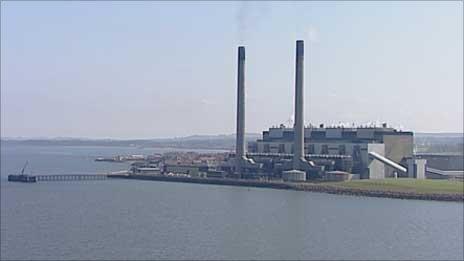Coal power plant at Cockenzie to be replaced by gas
- Published

The coal-fired power station at Cockenzie will be replaced
Plans to replace a coal-fired power station at Cockenzie in East Lothian with a gas turbine power station have been approved by ministers.
The Cockenzie power station, which is 40 years old, will be demolished and replaced by a new plant.
The Scottish government said natural gas was more efficient than coal and would more than halve carbon and nitrogen dioxide emissions.
A separate application for a new gas pipeline was also approved.
It will run for 17.5km (11 miles) from the existing gas network at East Fortune to the new power station.
The government said that the new power station would be "carbon capture ready".
Generating process
Carbon capture and storage (CCS) aims to capture emissions, turn them into liquid and stored it underground, if that technology can be proven.
The new power station will be required to fit full carbon capture and storage technology once it is viable.
Energy Minister Fergus Ewing said: "Alongside the vast increase in renewable energy that we are working towards, Scotland will still need conventional, clean fossil fuel power to provide a steady supply of electricity.
"This could be met by new-build plant, upgrades to existing plants or a combination of both."
Mr Ewing added that the Cockenzie development was designed to use the heat produced during the electricity generating process for other purposes.
The minister said he had published a new study on waste heat which showed it was technically possible to recover significant amounts of heat at large power stations but that the financial case remained unattractive.
Keith Anderson, chief corporate officer at Scottish Power, which operates the plant, said: "The current coal power station is reaching the end of its operational life and has to close by the end of 2015.
"In the meantime our plans for the gas station will see further development work carried out in the coming months.
"This will fully establish our plans for the site and determine the design and future timetable for the project."
Scottish Power Generation Limited applied to Scottish ministers for consent to construct and operate a 1000MW gas-fired Combined Cycle Gas Turbine (CCGT) generating station in 2009.
East Lothian Council formally withdrew its objection to the proposal in December 2010.
Environment group WWF Scotland said it was "extremely disappointed" by the announcement.
Head of Policy Dr Dan Barlow said: "By not requiring any carbon capture from the start this decision risks locking Scotland into decades of unabated climate pollution and jeopardises the government's firm commitment to decarbonise energy supply by 2030.
"The government's own energy policy shows that Scotland doesn't need any new gas or coal to keep the lights on.
"If this poor decision is later followed by the approval of a new coal-fired power station at Hunterston then Scotland can kiss goodbye to any credibility it currently has globally as a leader in tackling climate change."
Mr Barlow added: "Despite the Government's claims that it wishes to promote the most efficient use of waste heat in generating electricity this proposal provides no firm commitment to actually recover and use any waste heat.
"A new fossil-fuelled power plant operating at just over 50% efficiency has absolutely no place in Scotland's power sector."
Scottish Lib Dem environment spokesman Jim Hume said: "The potential existed at Cockenzie for either a high-efficiency combined heat and power plant, or a plant that could demonstrate commercial scale carbon-capture technology from the start of its operation.
"However neither of these two options have been fully explored on this occasion, which is disappointing in terms of Scotland's commitment on cutting carbon emissions."
Scottish Labour leader Iain Gray, the MSP for East Lothian, welcomed the decision.
He said: "East Lothian needs the demolition and construction jobs it will create. We need the permanent jobs that the station will sustain and Scotland needs the cleaner electricity that it will generate.
"The new gas-fired power station will be far cleaner than the coal-fired power station it will replace so this is good news not just for local employment, but also for our environment."
- Published12 September 2011
- Published9 June 2011